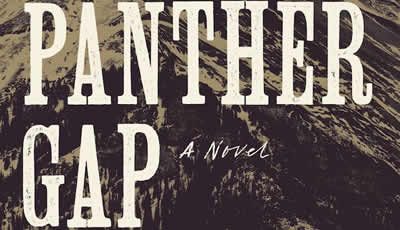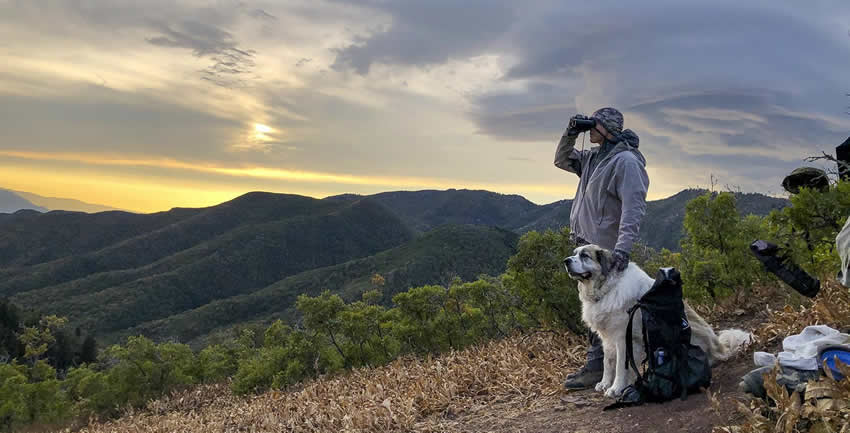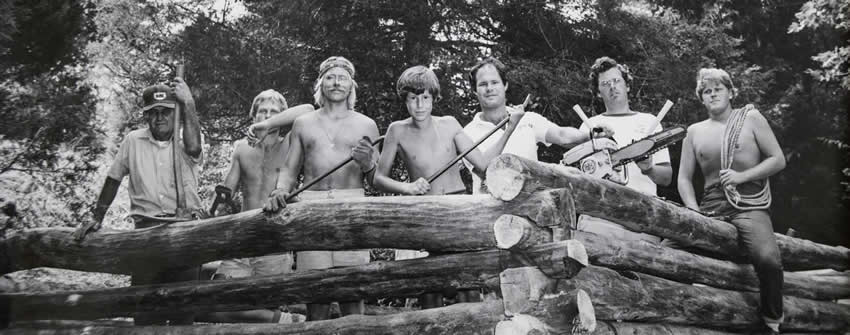

Features Up Close: James A. McLaughlin
Inspired by Nature
 By Dawn Ius
By Dawn Ius
James A. McLaughlin’s award-winning debut, Bearskin, had the kind of acclaim most writers only dream about. The novel not only earned praise from the likes of bestselling author C.J. Box, it picked up a coveted Edgar award, and secured him a second book deal.
But getting that second book out—this month’s PANTHER GAP—was no easy task.
McLaughlin says he was fortunate to have an agent and editor generous and patient enough to walk him through the sophomore blues—but the pressure he put on himself was far less gentle.
“It’s a cliché but still true that an author publishing their first book at an advanced age has poured their entire life into that book,” he says. “If there’s any success, the second book is expected within a few months. Some authors respond to that dynamic with an outpouring of productivity and professionalism. Others just freak.”
The story that became PATHER GAP was a project McLaughlin had worked on intermittently for a number of years, so he wasn’t entirely starting from scratch. But it took four years to make the novel publishable…and readers will be glad he persisted. It’s worth the wait.
The novel is about two siblings—once close, but in recent years, somewhat estranged—who are brought together to claim a potentially dangerous inheritance from their grandfather. Things get messy from there. What isn’t messy is McLaughlin’s prose, which perhaps paints one of the most compelling pictures of the rugged American West.
In this exclusive interview with The Big Thrill, McLaughlin talks more about how a dream inspired the plot and how his love of nature inspired the setting.
In PANTHER GAP, we return to many of the elements that made your debut so compelling—gorgeous prose, a page-turning plot, and fully developed characters. I was truly struck by how you write about the environment—there’s an authenticity there without leaning on common descriptors or clichés. Can you share a little about the importance of setting and how it enhances a story that moves at such a rapid pace? Do you have a personal connection to “nature” that feeds your work?
I’m as spoiled and materialistic as anyone, but I’ve never been able to live wholly suspended in the physical and psychological scaffolding of contemporary civilization. In life and in stories, now and then I need to reach a leg down and plant a foot on the ground. I’m sure a lot of literature works just fine without the slightest hint of “nature” (thanks for the scare quotes!), but I find I’m incapable of imagining a story where all you see are social primates obsessed with each other and their artifacts, where the more-than-human world around them—whether urban or not—is static, passive, unperceived except on the most superficial level. Even when events are unfolding at a fast pace, with the characters reacting, responding, making choices under pressure, it’s generally happening in physical space, and in any of my settings, that space is inhabited by other animals, plants, bugs, parasites, etc., and the human activity is having an effect on those beings, and vice versa. I try not to ignore that. Also, when things are happening quickly, sometimes you want the writing to slow down a bit, to better build and draw out the tension and resolution. Acknowledging some of the other beings present, the geographical context, meteorological forces, and so on…for me that’s one way to slow it down when the action is fast.
In the story, we’re introduced to siblings Bowman and Summer who were once close, became estranged, and must now come together to claim their inheritance. Of course, that’s a simplified description of a complex relationship that becomes even more complex as the story moves forward. I’d love to hear a little about how those characters took shape for you.
It sounds implausible, but the germ for each of the primary characters in PANTHER GAP came from a dream I had a long time ago: a boy (who became Sam in the novel), lost in the desert, finds a door in the wall of a canyon, out comes a girl (Summer), who invites him to her house, where they meet a weird older brother (Bowman), a scary dad (Leo), and a skeptical uncle (who split into Uncles Darwin and Jeremy). I wrote a short story that was basically a transcription of the dream, and over the years I would open it up and mess with it from time to time. Gradually, the characters gained flesh, taking on attributes, quirks, some lifted from my friends and acquaintances.

McLaughlin in his natural habitat, with Odin, one of the inspirations for the dog character in PANTHER GAP.
Photo credit: Nancy Assaf McLaughlin
Also, probably the most important driver for young Bowman and his father I adapted from a mention in Of Wolves and Men by Barry Lopez: the notion of a father talking his son into imitating a wolf so he could train his eagle to attack him, and how that might affect the son. So you take these things and work them in and—this sounds pretentious and writerly, like writing fiction is a kind of sorcery—at some point the characters take over, they seem to make choices, do things, on their own. I know it’s coming from my subconscious, but the impression is of real live persons deciding what to do. As Bowman became more of a rebellious mystic, Summer went the other way, growing more practical, more responsible and considerate, incapable of blowing off familial obligations for what she considers selfish impulses. Conflicts accumulate, and the characters’ relationship deepens and becomes more complex.
There seems to be a reemergence in stories set in a “western” environment—one only needs to look to the popularity of shows like Yellowstone (and its many spin-offs) to see it continually growing in popularity. Why do you think audiences and readers are keen to return to this setting, and what drew you to it?
It’s pretty interesting, isn’t it? I’m no sociologist, no TV critic…maybe it’s in part the sheer bigness of life in the rural west. There’s the much-talked-about notion that people on the coasts and in cities felt stifled during the worst of the pandemic, triggering a movement to remote work in scenic rural America by folks with the privilege to do so. Certainly there’s more space in the west, and “rugged folk who live and work outdoors, who actually need their trucks and SUVs.”
For me, wanting to spend time out west dates to childhood. I read a lot of Zane Grey, among many others, and even in high school I tried to write my junior year English paper on Louis L’Amour. My teacher, who later became a poet laureate of Virginia, had fun vetoing my choice, but he did steer me toward Jack London, so the theme continued. I started visiting the west after college, indulging in several aimless wanderings from west Texas and southern Arizona to the northern Rockies, and eventually my wife and I moved to Utah, allowing me to spend even more time doing “research.” What I’ve found most compelling is the space, the scale of things: mountains, animals, big swaths of land where industrial humanity’s bootprint is relatively minimal, or at least minimally visible. I still love the Appalachians and the Valley of Virginia, that’s where I imprinted, and I have the fantastic luxury of being able to return to that land and walk the same fields and forests that captivated me as a child. But the west has a large piece of my heart, and it’s a place where my imagination is active.
What do movies / TV tend to get wrong about the environment you’ve set your novel in?
Well, I first have to cop to the certainty that I got a lot about the environment wrong myself. I did some of that on purpose: Panther Gap, the place, is basically a high-elevation valley transplanted from the San Juan mountains sixty miles southwest to the arid corner of Colorado. I also populate the valley with a fanciful complement of charismatic megafauna. I did these things consciously, to serve the story, though some readers may object. But to your question, yes, the typical depiction of wild country, especially western wild country, in movies and TV often drives me nuts. This is a small thing, but it’s like there’s one single audio clip that every director, or maybe it’s the foley people, use and re-use for any large bird circling overhead…it’s a strict rule, never broken: if you show a bird circling, you have to play the red-tailed hawk call, that long high skreee sound. It’s the default call for eagles, other hawks, falcons, even vultures. And…bears are bad and scary and generally choose to attack; wolves are often dangerous to people; and by now everyone realizes Native Americans have historically been depicted in the most bone-headed, stereotypical, insulting ways, though that might be improving in recent years. I could go on and on.
PANTHER GAP embodies many of the classic elements we’d expect from a western-style story—though admittedly, the book defies most genre conventions in the best way. Were there any particular tropes you were careful to avoid?
One that comes to mind is the triumphal violent shoot-em-up defense of the homestead. I mean, I do have that, but it’s out of the main characters’ control, twisting the cliché and (I hope) subverting it somewhat. The violent defense of the home place is there, but it’s a little uncomfortable.
What challenges came with writing PANTHER GAP that you didn’t encounter with Bearskin?
Mostly, I didn’t have 20 years in which to rewrite it a hundred times, though I tried. Also: pandemic. I had big plans to wander the Four Corners area and southern Arizona, interviewing law enforcement officers, camping out, hiking with my cousin near the border. None of that happened, so I had to draw on memory. I wrote a good bit of close third person narrative for a female character, both as a girl and as an adult. That was a new challenge. And PANTHER GAP developed into a more complex, wide-ranging story than Bearskin, requiring a somewhat different approach to story-building.
It’s sometimes difficult to pull off a dual timeline story, but you successfully take readers through the past and present in PANTHER GAP. Was it more difficult to write one timeline vs the other? What’s the key to nailing dual timelines in a novel?
I hadn’t thought of this before, but yes, the childhood timeline was easier because I had the luxury of dipping in at any point in a 20-plus-year period when something important or particularly telling happened. Most of the present timeline only covers a few days, so that narrative is nearly continuous and I had to do a lot more coordination/choreography of the characters’ movements. I made these ridiculous, detailed charts of what was happening where and when, and still things kept running off the rails, necessitating revisions just to avoid time gaps and logical impossibilities. And I don’t know if this is the key, but I found the dual timeline works best if there’s some narrative cross-pollination between the two, where each timeline provides information—revelations—important to the other.
Aside from a compelling read—which PANTHER GAP truly is—what do you hope readers take away from this story?
It’s not necessary, but I would love it if a few readers are willing to engage empathetically with the characters’ different—and far from mainstream—perspectives: Leo determined to raise his children so as to avoid the neuroses of modernity; Bowman struggling to understand why he was raised to love a world already lost and why humanity went insane at some point in the distant past; Summer making sacrifices and hard choices to ensure the family can hang on to, and protect, the land they love. And maybe consider whether Uncle Jeremy might be right about despair, that it should be avoided, not because things aren’t hopeless, but simply because it gives you away as someone who fell for the happy horseshit in the first place.
Can you tell us a little bit about what you’re working on now?
I’m about a fifth of the way into a sequel to Bearskin, set mostly in the mountains of Virginia but with plans for a road trip out west and another encounter between Rice Moore and Summer Girard. We’ll see what happens.
- On the Cover: Alisa Lynn Valdés - March 31, 2023
- On the Cover: Melissa Cassera - March 31, 2023
- Behind the Scenes: From Book to Netflix - March 31, 2023




